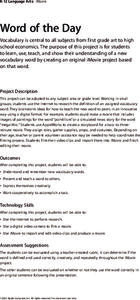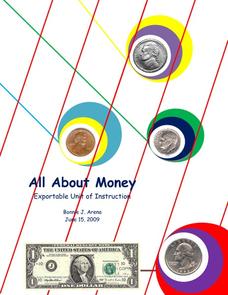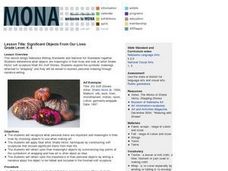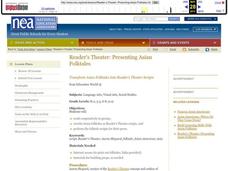Curated OER
Choose Your Words Wisely
Improve word choice! Writers use dictionaries and thesauruses to aid them in choosing exciting words to incorporate in their writing. They rewrite sentences and practice identifying words that can be replaced using a better word....
Curated OER
Alphabet Sideshow
Students practice sound and recognition of letters in alphabetical sequence. They gain an understanding of letter sounds and order. They create a slide show with graphics and text. They present their slide show to the class.
Curated OER
Word of the Day
Students practice using their new vocabulary word by creating an original iMovie project based on that word.
Curated OER
All About Money
Few topics engage young mathematicians as much as learning about money. Through a series of shared readings and hands-on activities, children explore the US currency system, learning how to count money and calculate change as they create...
Curated OER
Introduction to Melodic Notation: Sol-Mi
Second graders sing melodic sol-mi songs for teacher and student assessment. Emphasis is placed on drill and practice while developing melodic singing skills. Students evaluate performances and activities using pre-determined rubric...
Curated OER
Significant Objects From Our Lives
Students determine what objects are meaningful in their lives and look at artist Sheila Hicks' soft sculpture titled Six Soft Stones. Students explore the symbolic meanings attached to the art form of "wrapping" and wrap a meaningful...
Curated OER
On Your Mark, Get Set, Read
Students improve their reading fluency through the use of various strategies. After reviewing decoding and rereading strategies, students work with the instructor to complete a timed assessment of their words read per minute.
Curated OER
TELL THE SEQUENCE IN AN ORAL REPORT
Second graders survey a favorite story he/she has read or heard read aloud. They use the graphic organizer to draw illustrations that show the beginning, middle and end of the story. They tell the title of the story, whether it is...
Curated OER
LOOKING AT A CHARACTER
Second graders investigate self- and teacher-selected literature (e.g., picture books, nursery rhymes, fairy tales, poems, legends) from a variety of cultures. They re-enact and retell stories, songs, poems, plays, and other literary...
Curated OER
Scrapbook of Evidence
Students read three different genres of fiction. They create a story map and brainstorm possible collage inclusions. Each student prepares a minimum of two scrapbook page entries for each text or passage. Students write beside each...
Teaching Tolerance
Identity Artifacts Museum
Who are you? It's a simple question, but younger learners have the opportunity to express their complex identities by making artifacts that represent parts of their identities. After engaging in the activity, they share who they are with...
Lerner Publishing
Meet the Dinosaurs
Take your class of youngsters on a prehistoric adventure with this four-lesson series on dinosaurs. Accompanying the Meet the Dinosaurs books by Don Lessem, these lessons engage children in writing their own dinosaur books,...
Curated OER
Greetings and Introductions
Students recite common forms of courtesy, greetings and leave takings appropriate to the time of day. They practice identiying the differences in forms of address for age and rank. Pupils are each given a copy of the "Greetings and...
Curated OER
Write Me a Story
Second graders use the writing process and submit a story to www.kids.com. In this story writing lesson, 2nd graders choose a topic for a story contest. Students develop their stories. Students complete a her...
Curated OER
Daily Writing from Self Selected Reading
Second graders practice their reading comprehension by analyzing stories they read in class. In this children's literature instructional activity, 2nd graders are assigned to read a book for 20 minutes each day in class and also reflect...
Curated OER
Family Names
Young scholars draw a family tree. They label familiar items (e.g., family members, classroom objects, and pets). Pupils are given a copy of the worksheet "Family Name," they draw a family tree, label themselves and at least 10...
Curated OER
Harvesting Hope--Asking for Change Letters
Second graders compose friendly letters. In this writing lesson, 2nd graders read the text Harvesting Hope: The Story of Cesar Chavez and discuss the rights of farm workers. Students brainstorm things at school they would like to change...
Curated OER
Reader's Theater: Presenting Asian Folktales
Students create and perform folktale plays. In this reader's theater and Asian literature lesson, students work in groups to rewrite Asian folktales into scripts and perform the folktales for their class in a Reader's Theater. Lesson...
Curated OER
Apples! Apples! Apples!
Students explore the life of Johnny Appleseed as they create a MediaBlender project of Johnny's journey through the Midwest territory, and compare and contrast items he brought on his journey with items students would bring with them on...
Curated OER
How can we write a silly story?
Second graders use the writing process and create a silly story. In this silly story instructional activity, 2nd graders will review person, event and setting and complete a chart for each. Students will put a person,...
Curated OER
Adventure Into The World of Shapes
Students view Elmer Holtzrichter's work Mystery Planet and discuss basic shapes and patterns. They create their own collage. and discuss the patterning they created. Students demonstrate how this pattern would sound with clapping and...
Curated OER
Write All about It (Cooperative Learning)
Students listen to a read aloud and while working with other students, write alternate ending to the story.
Curated OER
Write A Description
Students practice composing sentences that pertain to the description of a picture. They use critical observation skills in order to derive the best details. The sentences are required to follow the correct subject and verb pattern.
Curated OER
Create a Poem
Students write three simple rhyming poems and read them aloud with rhythm. Students select two adjectives that are opposites and two rhyming verbs to create rhyming lines of the same length with an adjective-noun-verb pattern.























